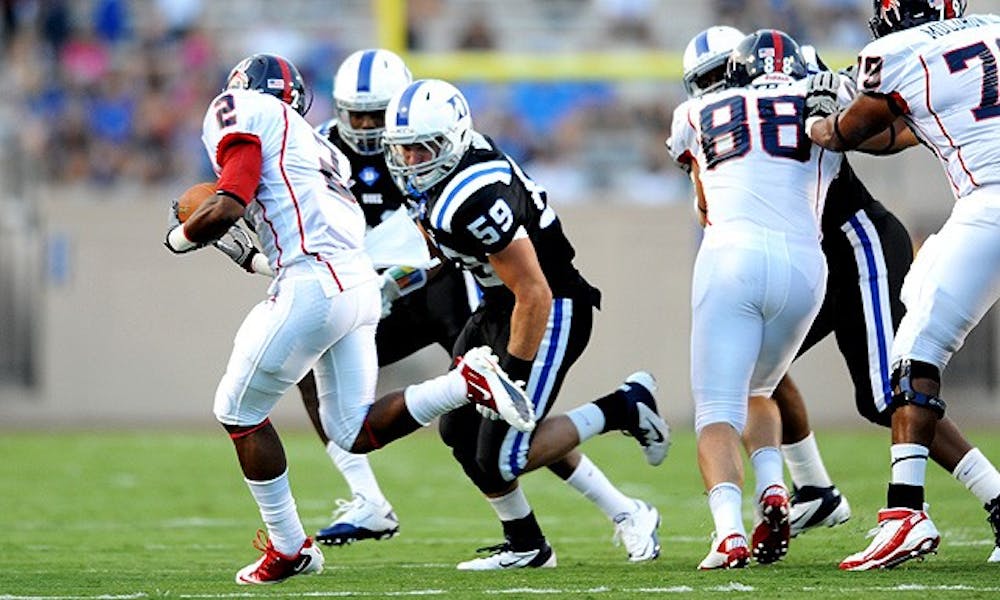The 2011 U.S. News and World Report national university rankings indicate that Stanford is considered the fifth-best research institution in the country, while Duke comes in at ninth. A similar glance at the AP Top 25 football rankings reveals that Stanford is ranked as the sixth best team in the country, while Duke is predictably absent from the list.
There is not a significant difference between being ranked fifth and ninth in academic rankings that are shaken up every year to sell a new issue. However, the fact that Stanford is a top-10 football program, yet Duke would likely not make the AP rankings if they were expanded to seventy-five teams, should be alarming to the Blue Devil faithful.
For too long, the Blue Devils have allowed themselves to be trampled on by teams from the rest of the ACC and around the country. The excuse has always been that Duke is a small private school with a sterling academic reputation, so the struggles on the gridiron should be expected.
No longer should this free pass be extended, thanks to programs like Stanford, Northwestern, and Wake Forest—teams that haven’t been asking for a handicap, but instead are finding a way to win despite their academic standards and smaller fan bases. These schools have been able to win, despite fielding inferior athletes, by recruiting to their unique systems—and there is no reason Duke cannot do the same.
Now, having student-athletes who are serious about the former part of that hyphenated word should be a source of pride for Duke players, coaches, and administrators. And it is for a group that had a 95 percent graduation success rate in 2010.
“It was one of the reasons that I decided to come here,” sophomore Ross Cockrell said. “Duke has a reputation that is second to none. Everybody wants to go to the NFL, but you have to have a backup plan, and going to Duke secures that backup plan.”
Still, it is not just about the classroom. The coaching staff is confident that the quality of players they are signing is much improved, and while acknowledging the importance of academics, ability on the field seems to be emphasized above all else. In fact, several players acknowledged that they didn’t think academics were a major selling point in their recruitments.
“If a guy can’t play football, I don’t care what his grades are,” head coach David Cutcliffe said. “We’ll hunt football players and then get into their academic commitment and their character commitment.”
In terms of attracting talent, the Cardinal will come into Wallace Wade with a roster that features five preseason All Pac-12 performers, including a Heisman Trophy frontrunner and likely top pick in next year’s NFL Draft, quarterback Andrew Luck. The Stanford coaching staff has meticulously assembled a group of talented players that, more importantly, fit their system, allowing them to create a winning formula. All the while, they have maintained an impressive graduation success rate of 86 percent, best among the top-25 ranked teams in Division I.
“You can build a team in several different ways,” linebacker Kelby Brown said. “Stanford has smart kids there, and they have a very successful program. You can build a team around guys that are smart, work hard, and want to do their job.”
Using that template, Stanford has made bowl appearances the last two seasons, losing a tightly contested Sun Bowl to Oklahoma in 2009 and blowing out ACC champion Virginia Tech in last year’s Orange Bowl. While the Cardinal did have a few futile years in the middle of the decade, its halting of USC’s 35-game home winning streak in 2007 showed that it, even in a down season, was capable of competing with a team consistently boasting top recruiting classes. This clearly has not been the case for Duke.
Northwestern and Wake Forest, the other two programs that offer the best peer comparison, have also had success earning bowl berths in the last decade. Northwestern has gone to five bowl games over that time period, including each of the last three seasons, and Wake Forest has played in four postseason contests, including the 2007 Orange Bowl after going 11-2 and winning the 2006 ACC championship.
The point is not that the Blue Devils should be competing for a national championship. Still, they should be able to qualify for bowl games in seasons where they have a more experienced roster and be competitive enough to pull off four or five victories even in rebuilding campaigns.
It doesn’t seem like anyone in Durham disagrees that the work of ex-Stanford head man Jim Harbaugh serves as a how-to-kit for Duke—the Blue Devils need to start by recruiting the right players for its system.
“I’d like to go beyond their model, that’s the approach to take,” Cutcliffe said. “I’m very complimentary of what they’ve done as an elite academic institution. I’m proud of what Stanford has done for college football. We’re on that path, that is where we’re headed.”
Get The Chronicle straight to your inbox
Signup for our weekly newsletter. Cancel at any time.

